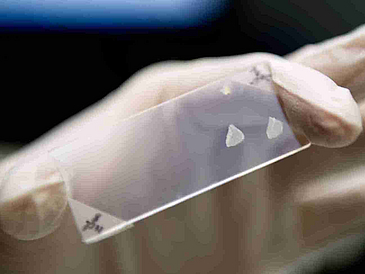The EU project with the title “EngCaBra” (short for “Biomedical engineering for cancer and brain disease diagnosis and therapy development”) has investigated new approaches to the diagnosis of cancer and brain diseases. A total of eight research groups in seven different countries were involved in the four-year project. Professor Michael Vellekoop from the University of Bremen’s Institute for Microsensors, -Actuators and -Systems (IMSAS) led the project with its four subprojects. The research objective was to develop new techniques for diagnosing cancer. The results produced by the Bremen subproject were particularly impressive: A newly developed biopsy analysis using an infrared quadruple-wavelength sensor will in future make it possible to simplify the otherwise complicated process – and thus contribute towards reducing the incidence of wrong diagnoses.
Especially the cross-disciplinary cooperation between the departments of electrical engineering, micro sensors, nanotechnology and biotechnology led to completely new diagnostic techniques that can be applied to the analysis and treatment of melanomas, leukemia and schizophrenia. What all these diseases have in common is a cell malfunction. The results produced by the Bremen subproject were particularly impressive: A newly developed biopsy analysis using an infrared quadruple-wavelength sensor will in future make it possible to simplify the otherwise complicated process – and thus contribute towards reducing the incidence of wrong diagnoses.
Results of the Bremen project
Professor Michael Vellekoop explains, “Deciding on a positive or a negative diagnosis is not so easy and mistakes are not uncommon. In the absence of a clear-cut diagnosis, patients often have to undergo further expensive examinations. Surveys have shown that about seven percent of melanoma diagnoses are wrong. This means that in every 100,000 cases, 6,600 people are wrongly diagnosed as having cancer and receive treatment and even operations quite unnecessarily”. Moreover, in such a sample some 400 people actually suffering from cancer are wrongly diagnosed and consequently receive no treatment at all.
There is, therefore, great interest in exploring new diagnostic techniques. The leader of the Bremen project goes on to explain, “In our Bremen subproject we work with infrared light. Human cells contain very long chains of CH2 molecules that oscillate in different ways – symmetrically or anti-symmetrically. In both cases they absorb infrared light, but at different wavelengths. Our new instrument measures how much light is absorbed for both oscillations. In cancer cells the ratio of symmetrical versus anti-symmetrical changes. This change shows an alteration in the tissue, and therefore the presence of a disease.” This makes it possible for researchers to carry out accurate analyses and even compare different segments of one biopsy. The technique was developed in cooperation with a researchers and a medical doctor from the Medical University of Vienna.
When will it be possible to put the new technique into practice?
Vellekoop is very excited about the breakthrough. “In future we will most definitely be able to reduce the incidence of wrong diagnoses. The next step is for the Microsystems Center Bremen (MCB), our organization for maintaining contact with industry, to find a firm willing to further develop the instrument with us. I think all hospitals will be able to afford the device – it should cost less than 20,000 euros, possible even half that much.”
Another project result
In one of the other subprojects of “EngCaBra” a technique for investigating the melting behavior of proteins in blood has been realised. The method was developed by the Dutch project partner Xensor Integration B.V. Using a new physical procedure, proteins in blood serum are heated very quickly (heating speed 240.000 Kelvin/min.) in a small silicon-based sensor chip. Variations in the melting point of the proteins serve as an indication for cancer.
The European project EngCaBra encompasses the following partners:
- Department of Biosystems Science and Engineering, ETH Zürich, Switzerland
- Department of Micro- and Nanotechnology, Technical University Denmark, Lyngby, Denmark
- Department of Molecular Medicine, Institute of Virology, Slovak Academy of Sciences, Bratislava, the Slovak Republic
- Institute of Pathophysiology and Allergy Research - Biotechnology, Medical University of Vienna, Austria
- Department of Veterinary Disease Biology, University of Copenhagen, Copenhagen, Denmark
- Xensor Integration BV, Delft, the Netherlands
- Hoffmann-La Roche Ltd, Basel, Switzerland
- Siemens Austria, Life Science Systems, Research & Technologies, Vienna, Austria
- Copenhagen State Hospital, Copenhagen, Denmark
If you would like to know more about this topic, please contact:
University of Bremen
Faculty of Physics /Electrical Engineering
Institute for Microsensors, -Actuators and -Systems (IMSAS)
Prof.Dr. Michael Vellekoop
Phone: +49 421 218 62604
e-mail: vellekoopprotect me ?!uni-bremenprotect me ?!.de
www.imsas.uni-bremen.de/
EngCaBra homepage: http://www.engcabra.eu/

